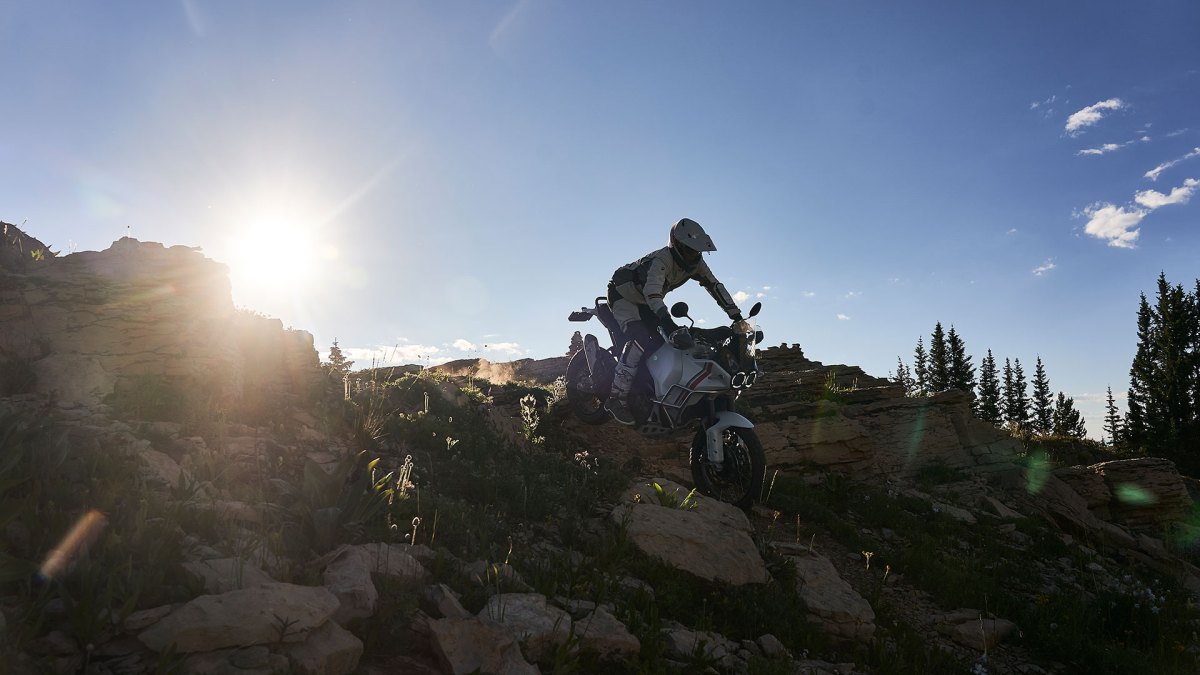[ad_1]
Adventure bikes (also known as ADV bikes) are increasingly popular in the US for a few reasons. They’re rideable on pavement or off-road, the riding position is relatively upright, the bars are at an all-day-comfortable-for-your-arms angle, there’s a smallish windscreen that offers just enough protection, and the tank is cut like a motocross machine to give your knees purchase against it (so a thigh squeeze lets riders easily drive the bike through corners). A great adventure bike puts the rider at the best angle for long-mile comfort, so they have an interesting experience that won’t feel uncomfortable after 100 miles.

The Ducati DesertX happens to be operating at the apex of what the breed can offer. Unlike the brand’s Scrambler—which was modded to look butch enough for dirt—Ducati started the $18,295 DesertX from scratch, thinking about off-road attributes first.

A significant feature of that approach is the 937cc liquid-cooled Testastretta 11-inch twin engine. Liquid cooling truly helps when delicately tip-toeing a path over a rocky washout at low speeds—especially when you might be doing that for several hours at a stretch, which could easily lead an air-cooled engine to cook through its oil and wear out prematurely.

Off-road riding also requires gearing that allows for consistent movement at slower speeds, which is why Ducati didn’t just take the cogs from their Multistrada V2 and swap them across. Instead they use shorter first and second gears, and one through fifth gears are all shorter, with a much taller sixth—the latter change in order to lower revs at highway speeds and save fuel. Even the rear cog, at 49 teeth (more than the Multistrada V2’s 43) allows for churning along very slowly and carefully. All that’s important when the aim is to maintain control at one to 20mph. Too-tall gearing would fight the other direction.

Those who didn’t think Ducati would make a “real” ADV bike will think twice seeing an 18-inch rear wheel and a 21-inch front. A taller wheel creates a longer lever to “pry” over water bars and potholes, and the slower you ride, the more you risk a smaller wheel getting swallowed, stalling your forward momentum. (Mountain bikes went from 26 to 27.5 and 29 inches precisely to address that levering problem.)
Specs only go so far, though. We’ve ridden more than a few bigger displacement ADV bikes that have great numbers but don’t handle the way this Ducati can—and that all comes down to balance. While the DesertX is hardly light (at 492 pounds fueled, it’s leaning toward the heavier end of the category), it rides like it’s actually much leaner. Rather than understeering though corners (which unfortunately is a pretty common trait for some bigger machines) the DesertX obeys subtle cues and lets a rider drive a knee into the tank and steer the bike with the lightest handlebar inputs.

Off-road, it’s just as friendly. That’s aided by a near-mesmerizing number of settings, but the easiest to access is Enduro, which cuts horsepower from the maximum of 110 down to 75, but also allows more rear wheel spin—which you will need to get the DesertX to climb a long, loose-surfaced hill. Luckily that gearing is a friend here. On the road, third gear seems to last forever and allows riders to use engine braking rather than the meaty discs at the front and rear to adjust to every apex and rocket past them. On the dirt, second is the most versatile, letting riders chug along and focus. It really helps that there’s plenty of suspension travel (9.1 in the front and 8.7 out back) and nearly 10 inches of ground clearance.
The 34.4-inch seat height isn’t for everybody, but Ducati thought of this and made both a lower and taller seat so riders of all heights can get comfortable. Whether standing up on the pegs or stretching their legs out, riders will easily find a natural position.

The bike’s designers also took a chance on a different style display, and it’s very smart. Taking a cue from phones, they rotate the TFT (Thin Film Transistor) from horizontal to vertical. Riders can customize the information they see. But the most brilliant result is that a tall, instead of wide, display is more readily visible when you stand up on a bike. Riders can see navigation (by pairing a phone) and other critical info without missing a beat—or a left turn.

While some think the DesertX looks a little retro, thanks to the faired-in beak-like nose, a closer look at the architectural tank and the ringlet LED running lights reveals that Ducati has crafted something more timeless. This may be their first “serious” ADV bike, but judging by how many heads swiveled when riders saw the DesertX during our test ride, they have a hit—and it sure won’t be their last moto within the genre.
Hero image courtesy of Ducati
[ad_2]
Source link https://coolhunting.com/design/test-ride-ducatis-desertx-adventure-motorbike/

Leave a Reply
You must be logged in to post a comment.